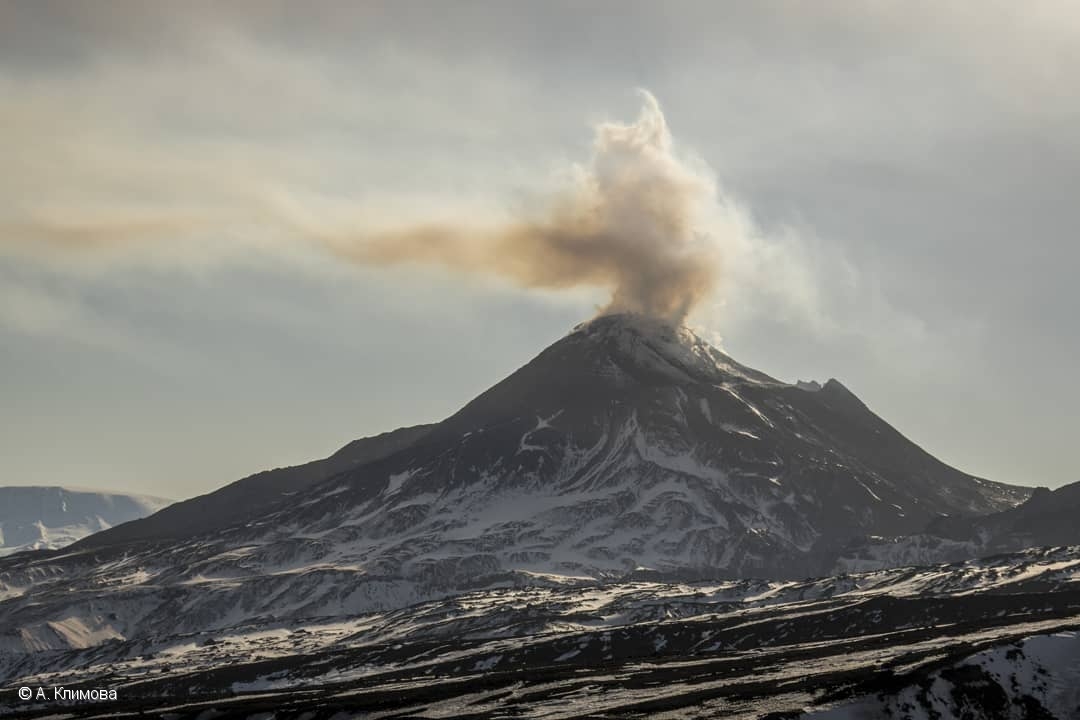Report on Bezymianny (Russia) — June 2019
Bulletin of the Global Volcanism Network, vol. 44, no. 6 (June 2019)
Managing Editor: Edward Venzke.
Bezymianny (Russia) Ongoing thermal anomalies, gas-and-steam plumes, and lava dome growth during February-May 2019; strong explosion in mid-March
Please cite this report as:
Global Volcanism Program, 2019. Report on Bezymianny (Russia) (Venzke, E., ed.). Bulletin of the Global Volcanism Network, 44:6. Smithsonian Institution. https://doi.org/10.5479/si.GVP.BGVN201906-300250
Bezymianny
Russia
55.972°N, 160.595°E; summit elev. 2882 m
All times are local (unless otherwise noted)
Volcanism at Bezymianny has been frequent since 1955. During the last reporting period, observations primarily consisted of moderate gas-and-steam emissions and thermal anomalies. Lava dome growth has been reported, as well as the effusion of several lava flows onto the dome flanks. Monitoring is the responsibility of the Kamchatka Volcano Eruptions Response Team (KVERT). Activity during February to mid-March 2019 consisted of predominantly moderate gas-and-steam emissions. Incandescent, hot avalanches from the lava dome, strong fumarolic activity, and a thermal anomaly began to occur in mid-March 2019. This reporting period includes activity from February-May 2019.
One explosion occurred during this reporting period. According to video data from KVERT and seismic data from the Kamchatka Branch of the Geophysical Service, on 15 March 2019 an explosion sent ash up to an altitude of 15 km. According to the KVERT Weekly Reports, satellite data showed large ash clouds from this eruption drifting several thousands of kilometers east from the volcano. The Volcano Observatory Notice for Aviation (VONA) issued by KVERT for this event described ash clouds to a distance of about 870 km. Ashfall was reported in Ust'-Kamchatsk (115 km E) on 15 March and Nikolskoe (350 km E) on 15-16 March 2019.
Beginning 15 March and continuing through May 2019, the number of hot avalanches from the lava dome top significantly increased, as well as the temperature of the thermal anomalies as reported by KVERT based on satellite data. Incandescent lava dome growth with extruding, viscous lava flows accompanying strong fumarolic activity and thermal anomalies continued in late April-May 2019 (figure 30).
 |
Figure 30. Fumarolic plume rising above at Bezymianny on 14 April 2019. Photo by A. Klimova, courtesy of the Institute of Volcanology and Seismology FEB RAS, KVERT. |
MODIS infrared data processed by MIROVA showed stronger and more frequent thermal anomalies in mid-March 2019 compared to the typical thermal activity since late January and afterwards through May (figure 31). According to the MODVOLC algorithm, 11 hotspot pixels were recorded between February and May 2019.
 |
Figure 31. Thermal anomalies at Bezymianny for September 2018 through May 2019 as recorded by the MIROVA system (Log Radiative Power). Courtesy of MIROVA. |
Geological Summary. The modern Bezymianny, much smaller than its massive neighbors Kamen and Kliuchevskoi on the Kamchatka Peninsula, was formed about 4,700 years ago over a late-Pleistocene lava-dome complex and an edifice built about 11,000-7,000 years ago. Three periods of intensified activity have occurred during the past 3,000 years. The latest period, which was preceded by a 1,000-year quiescence, began with the dramatic 1955-56 eruption. This eruption, similar to that of St. Helens in 1980, produced a large open crater that was formed by collapse of the summit and an associated lateral blast. Subsequent episodic but ongoing lava-dome growth, accompanied by intermittent explosive activity and pyroclastic flows, has largely filled the 1956 crater.
Information Contacts: Kamchatka Volcanic Eruptions Response Team (KVERT), Far Eastern Branch, Russian Academy of Sciences, 9 Piip Blvd., Petropavlovsk-Kamchatsky, 683006, Russia (URL: http://www.kscnet.ru/ivs/kvert/); Institute of Volcanology and Seismology, Far Eastern Branch, Russian Academy of Sciences (IVS FEB RAS), 9 Piip Blvd., Petropavlovsk-Kamchatsky 683006, Russia (URL: http://www.kscnet.ru/ivs/eng/); Kamchatka Branch of the Geophysical Service, Russian Academy of Sciences (KB GS RAS) (URL: http://www.emsd.ru/); MIROVA (Middle InfraRed Observation of Volcanic Activity), a collaborative project between the Universities of Turin and Florence (Italy) supported by the Centre for Volcanic Risk of the Italian Civil Protection Department (URL: http://www.mirovaweb.it/); Hawai'i Institute of Geophysics and Planetology (HIGP) - MODVOLC Thermal Alerts System, School of Ocean and Earth Science and Technology (SOEST), Univ. of Hawai'i, 2525 Correa Road, Honolulu, HI 96822, USA (URL: http://modis.higp.hawaii.edu/).

